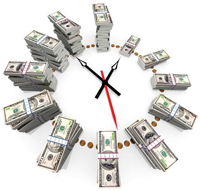IRR and Multiples
 Recently I saw curious deal terms from a private equity firm. The money people had Series A stock and received all the cash flow until certain conditions were met, at which point Series B holders would start to see money. There were two conditions and both had to be true for Series B to be in the money, i.e. the conditions are a threshold or hurdle to be overcome. The chart below shows how it worked: Recently I saw curious deal terms from a private equity firm. The money people had Series A stock and received all the cash flow until certain conditions were met, at which point Series B holders would start to see money. There were two conditions and both had to be true for Series B to be in the money, i.e. the conditions are a threshold or hurdle to be overcome. The chart below shows how it worked:
| Level |
IRR |
Mult |
Series B
Units %
of CF |
| 1 |
< 10% |
< 1.0 |
0% |
| 2 |
10% |
1.0 |
15% |
| 3 |
15% |
1.5 |
20% |
| 4 |
20% |
2.0 |
25% |
| 5 |
25% |
2.5 |
25% |
| 6 |
30% |
3.0 |
30% |
So until the Series A investors reach a 10% IRR AND a 1.0x, the Series B would get no cash. But once both conditions were met, Series B would get 15% of the cash flow. For Series B to get 20% of the next dollar, (Level 3), Series A would have to be at 15% IRR and 1.5x multiple. So much for the mechanics.
This was curious to me because I’ve rarely seen two-factor tests. I’ve seen IRR tests frequently, but I couldn’t recall seeing one that measured based on both IRR and Multiple. And what’s even more interesting to me is that IRR and Multiple are related. Think of it like this: if all investments lasted exactly one year IRR and Multiple look like this:
| IRR |
Mult |
| - |
1.00 |
| 10% |
1.10 |
| 15% |
1.15 |
| 20% |
1.20 |
| 25% |
1.25 |
| 30% |
1.30 |
Let’s look at an example where the entire investment is drawn on Day 1 and the full return is realized after one to seven years. In these cases, we can show the equivalent multiple for an IRR or vice versa. Consider this, based on the first table:
| |
|
Series B |
|
|
Year of Projection: Mult translated to IRR |
| IRR |
Mult |
Units % |
Level |
|
1 |
2 |
3 |
4 |
5 |
6 |
7 |
| -100% |
- |
0% |
1 |
|
|
|
|
|
|
|
|
| 10% |
1.0 |
15% |
2 |
|
0% |
0% |
0% |
0% |
0% |
0% |
0% |
| 15% |
1.5 |
20% |
3 |
|
50% |
22% |
14% |
11% |
8% |
7% |
6% |
| 20% |
2.0 |
25% |
4 |
|
100% |
41% |
26% |
19% |
15% |
12% |
10% |
| 25% |
2.5 |
25% |
5 |
|
150% |
58% |
36% |
26% |
20% |
16% |
14% |
| 30% |
3.0 |
30% |
6 |
|
200% |
73% |
44% |
32% |
25% |
20% |
17% |
The yellow cells in the table show all those cases where the multiple test implies a lower IRR than the IRR test does. In these cases the multiple rules. Of course, Year 1 is pretty obvious. What’s interesting is that by the time you get to Year 4, the Multiple test is irrelevant. For example, on Level 2 you need a 10% IRR and a 1.0x Multiple. This one actually makes me chuckle, because a 1.0x Multiple = 0% IRR by definition. So if you have a 10% IRR, you have always exceeded your 1.0x Multiple. And so it goes…the 1.5x Multiple with 15% IRR doesn’t matter after Year 3, and the other steps are pretty much irrelevant by Year 4.
 I will note that there is one good reason to put in a multiple test: if someone uses your money just to get the deal done, and then tries to replace you with cheaper financing, you could be hurt because a 20% IRR on 3 months of investment just isn’t that much, but you invested lots of time in getting the deal done, opportunity cost of missing other deals, etc. That’s when a 2.0x Multiple could really help. I will note that there is one good reason to put in a multiple test: if someone uses your money just to get the deal done, and then tries to replace you with cheaper financing, you could be hurt because a 20% IRR on 3 months of investment just isn’t that much, but you invested lots of time in getting the deal done, opportunity cost of missing other deals, etc. That’s when a 2.0x Multiple could really help.
But in general, this extra clause really doesn’t do much for the investor who asked for it. I do find that people get obsessed about multiples. I once had an argument with a fellow finance guy who insisted that investors only cared about multiple and never about IRR. I offered him a choice between two deals, both totally guaranteed payouts. Deal #1 let you invest for one year with a 1.5x multiple giving an IRR of 50%. Deal #2 gave a 3x multiple, but didn’t pay out for 30 years. Which is better? The 3x multiple is the equivalent of a 4.7% IRR, but that shouldn’t matter, right, since investors only care about multiple, right? This particular guy still couldn’t see past his axiom that “you can’t eat IRR,” but I bet most of us would still take Deal #1.
 In any case, the key thing that multiples miss is the time value of money whereas IRR does capture something important about time value. I’m still a purist and believe that discounted cash flow gives the true correct answer. IRR, while imperfect, is closer to DCF than are multiples, which are oblivious to the passage of time. In any case, the key thing that multiples miss is the time value of money whereas IRR does capture something important about time value. I’m still a purist and believe that discounted cash flow gives the true correct answer. IRR, while imperfect, is closer to DCF than are multiples, which are oblivious to the passage of time.
In the final analysis, I prefer a simpler single test to this more complicated structure. If investors can name their terms, they can make it as complicated as they want. But they can achieve 95% of their results with a simpler test that will be easier for everyone to accept.

|
|
|
Groupon Update
 Well, it finally happened. The NYT reports the latest step in the downfall of Groupon: Well, it finally happened. The NYT reports the latest step in the downfall of Groupon:
GROUPON DISMISSES CHIEF
 Andrew Mason, the irreverent chief executive of Groupon, was ousted on Thursday, after the company's dismal fourth-quarter results capped a string of disappointing quarters. True to his humorous style, Mr. Mason wrote in a letter to employees: "After four and a half intense and wonderful years as C.E.O. of Groupon, I've decided that I'd like to spend more time with my family. Just kidding - I was fired today. If you're wondering why... you haven't been paying attention." Andrew Mason, the irreverent chief executive of Groupon, was ousted on Thursday, after the company's dismal fourth-quarter results capped a string of disappointing quarters. True to his humorous style, Mr. Mason wrote in a letter to employees: "After four and a half intense and wonderful years as C.E.O. of Groupon, I've decided that I'd like to spend more time with my family. Just kidding - I was fired today. If you're wondering why... you haven't been paying attention."
|


 Recently I saw curious deal terms from a private equity firm. The money people had Series A stock and received all the cash flow until certain conditions were met, at which point Series B holders would start to see money. There were two conditions and both had to be true for Series B to be in the money, i.e. the conditions are a threshold or hurdle to be overcome. The chart below shows how it worked:
Recently I saw curious deal terms from a private equity firm. The money people had Series A stock and received all the cash flow until certain conditions were met, at which point Series B holders would start to see money. There were two conditions and both had to be true for Series B to be in the money, i.e. the conditions are a threshold or hurdle to be overcome. The chart below shows how it worked: I will note that there is one good reason to put in a multiple test: if someone uses your money just to get the deal done, and then tries to replace you with cheaper financing, you could be hurt because a 20% IRR on 3 months of investment just isn’t that much, but you invested lots of time in getting the deal done, opportunity cost of missing other deals, etc. That’s when a 2.0x Multiple could really help.
I will note that there is one good reason to put in a multiple test: if someone uses your money just to get the deal done, and then tries to replace you with cheaper financing, you could be hurt because a 20% IRR on 3 months of investment just isn’t that much, but you invested lots of time in getting the deal done, opportunity cost of missing other deals, etc. That’s when a 2.0x Multiple could really help. In any case, the key thing that multiples miss is the time value of money whereas IRR does capture something important about time value. I’m still a purist and believe that discounted cash flow gives the true correct answer. IRR, while imperfect, is closer to DCF than are multiples, which are oblivious to the passage of time.
In any case, the key thing that multiples miss is the time value of money whereas IRR does capture something important about time value. I’m still a purist and believe that discounted cash flow gives the true correct answer. IRR, while imperfect, is closer to DCF than are multiples, which are oblivious to the passage of time.  Well, it finally happened. The NYT reports the latest step in the downfall of Groupon:
Well, it finally happened. The NYT reports the latest step in the downfall of Groupon: Andrew Mason, the irreverent chief executive of Groupon, was ousted on Thursday, after the company's dismal fourth-quarter results capped a string of disappointing quarters. True to his humorous style, Mr. Mason
Andrew Mason, the irreverent chief executive of Groupon, was ousted on Thursday, after the company's dismal fourth-quarter results capped a string of disappointing quarters. True to his humorous style, Mr. Mason